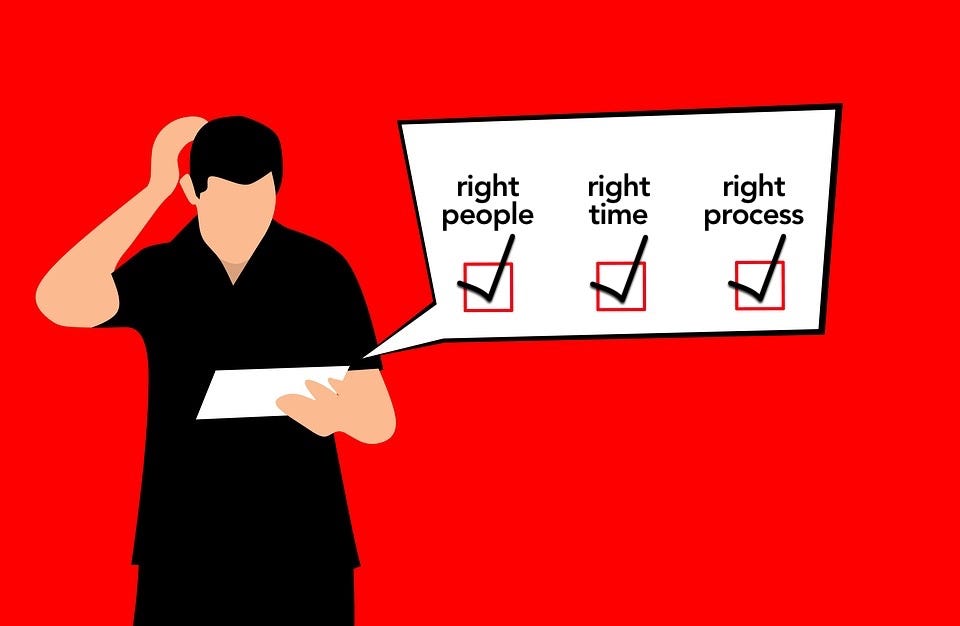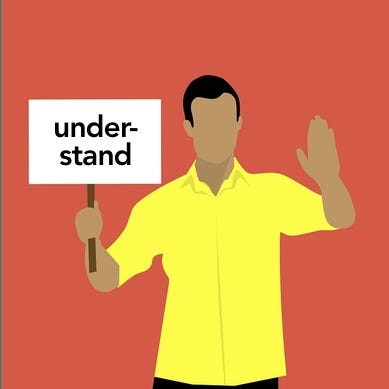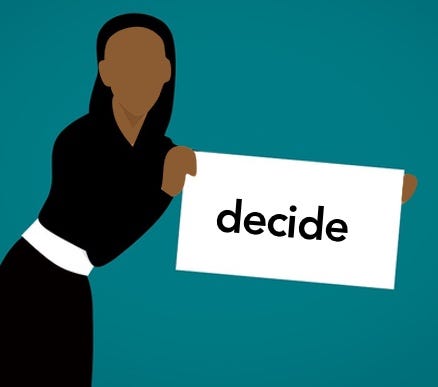Integrating objections in sociocracy
Intro — what’s an objection?
The decision-making method used in sociocracy is consent. Consent is different from consensus. How? The short version is that in (most forms of) consensus, we’re trying to come to a unanimous decision where everyone agrees. In consent, we’re trying to come to a proposal where no one objects. What’s the difference?

In consent, personal preferences are not as important as objections. We might try to get close to people’s preferences in the proposal forming process, but when it comes to decision-making, the focus is on objections. An objection means I have reasons to assume that making this decision is going to negatively impact our ability to achieve our aim. (The aim is a description of what the circle or role is doing.)
To object means to be wanting to work
This turn the notion of “objections are roadblocks” upside down. Objections are not roadblocks. They might be slowing down a meeting temporarily but in the long run, disregarding objections will cost you time, life energy and money. Why?

We assume that people want to work. Human beings want to contribute and do work well. We want to matter and have an impact — treading water might be meditative but it is not what we join a purpose-driven organization for. We join a purpose-driven organization because we see a need that we want to meet, and typically, that involves doing things, i.e. work.
So we assume that people want to achieve their circle’s or role’s aim. If someone wants to contribute and do good work and someone put obstacles in their way, they will notice and complain. And that’s exactly what an objection is. Recalling our definition was above: an objection is to say I have reasons to assume that making this decision is going to negatively impact our ability to achieve our aim.
So in saying no to a proposal, the objector says yes to working.
I remember just a week or two ago, a member of an organization I am the operational leader of was complaining a lot. Complaining is hard to listen to sometimes, it can be a lot of “so-and-so did this, this-and-that isn’t working”. But underneath the complaining, all I could hear from her was I want to work! Help me get those obstacles out of the way so I can enjoy doing what I am passionate about. That’s what an objection is.

Taking objections seriously means to listen
This is a vulnerable moment. In telling you about their objection, your team member indirectly told you about their passion, their values, maybe their fears.
I assume every reader can relate easily to the objector who wants to experience flow and ease in doing their work instead of roadblocks thrown their way. And even more importantly, I assume every reader can imagine what it feels like to be ignored at that moment. Think about it for 5 seconds. This is a moment where it hurts others if you mess up. If you brush off their real concern, say something dismissive or move on to the next topic, it will affect how that member — and everyone who witnessed the interaction — will show up in the future. This is a moment to shut up and listen. Or do you really want team members to stop talking about how they could do work better?
Integrating objections requires structures, intentionality, and skill
The tricky thing is that sometimes people complain when you’re not at your best. You might have all the best reasons to be pressed for time. You might not enjoy the style of complaining. You might not feel like you’re the one who can do anything about the complaints anyway.

- Right people: That’s why it’s so important to make decisions by consent in circles with authority in the first place. In sociocracy, authority is as local as possible. The people who can and want do something about the issue are the decision-makers. So asking for consent by a circle in distributed power will get you the right information — in the form of objections — to the right people.
- Right time: circle meetings create moments of intentionality, where we take time to look at our general decisions (aka policy), with enough time to listen to everyone. We make a review date, chosen by the group by consent, to make sure we have a way of working in new information. Create listening spaces — that’s what a meeting is. That way, people who are negatively impacted by a policy aren’t forced to drop by complaining. They have already been heard and they know when they will be heard again.
- Right process: We’re not always at our best. We might be attached to a proposal. We might be tired, impatient, or taken aback by someone’s style. And because we’re not always at our best, it’s best to have processes in place and good skills. You don’t do the rest of your work without training and preparation. Why not invest some time into good skills around listening and integrating objections?
Step by step
Next comes a step-by-step guide on how to approach objections. Actually, just having any system in place will help you respond with more ease when listening to the objection. You have a plan for that. Relax.
The concepts in this article are a shortened version from our comprehensive book Many Voices, One Song. In that book, we build on the basic building blocks for any decision: understand, explore, decide.

Understand
The first step is to understand the objection. Listen to the objector. Bite your tongue if you have a dismissive “but how is that a problem”-reflex. Trust that your coworker has something relevant to say if you really try to understand it. In our world, we work with a list of needs (from non-violent communication) to get a clearer picture of the underlying issue. What is absolutely necessary is to understand exactly how the objection interfere’s with the circle’s aim. Get curious. Ask all the questions you have.
“I want to make sure you can do good work that you enjoy. Help me understand how this proposal interferes with that.”

Explore
Once you have a good handle on understanding the objection, explore together how meeting the underlying need expressed in the objection can be integrated into your proposal.
Our preference is to do so in a round — asking every circle member one by one what ideas they might have. That way you have a lot of different perspectives, you can build on each other’s ideas to come up with even better ones, and the obligation is neither on the objector nor on the facilitator. Needs are universal, so we are not trying to please the objector when we integrate an objection — the objector has simply brought up a universal need and interference with our aim that the rest of the group might not have been aware of. More than once I have experienced an objection withdrawn by an objector, while then other team members found the objection important enough to address. In a word, don’t focus on the objector, focus on the shared aim and how you can achieve it well.
The section below this one, “How to integrate objections”, shows the standard strategies of integrating objections.

Decide
Once you have explored enough ideas, maybe in more than one round, it is the facilitator’s job to make sure a modified proposal will be brought to the circle. There might be more information needed, or a re-write or something else. Either way, make a move forward by making sure information is gathered, the re-write is delegated or whatever it takes. As soon as a new proposal is on the table, it will go for the consent process again.
Strategies of integrating objections
Objections come in all forms and flavors. Here are three basic strategies that you can use as standalone or in combination.
Option 1: Modify something
The first, very vague option is to change something. Examples:
- Objection: Not enough consideration for safety of data
Modify → make data safer with additional measure. - Objection: A membership fee of $500 will turn members away
Modify → $300 instead of $500
This will make much more sense in your specific context. The basic question is, can we modify something to make sure the need under the objection is met?
Option 2: Shorten the time frame
Another smart way of getting consent and moving forward is to shorten the time frame. Every policy comes with a “due date” when it needs a review. This time frame is set by the circle at the moment the policy is approved. In the case of an objection, you can now shorten the time frame. If 6 months seems too risky for you to try this out, would you be ok with trying with 2 months and then we re-evaluate? I have seen many objections integrated that way. The best thing is that this approach also gives us more information — after 2 months we will know much better what the impact of our decision has been.
This strategy works best if the objection seems vague and fueled by fear more than predictable data. It is often used in combination with option 3, measure the concern.

Option 3: Measure the concern
If someone raises a concern, for example the above scenario of someone expecting a drop in new members joining the organization because of an increase in membership fees, a good option might be to go ahead and just keep a close look at membership data. The truth is, for many decisions, we don’t know what will happen. Instead of debating hypothetical what-ifs meeting after meeting, let’s gather some data. What’s important here is to make sure that data is being tracked well and transparently, with a clear agreement on what thresholds will make alarm bells ring. For example, measure how many members join despite the increased membership fee, and survey them about the fee. Or measure how many visitors of your website leave your page the moment they see the fee. When they drop more than 30% in a week time frame, the decision will be reviewed right away.
This works best if there is a rather short, defined time plan, a solid plan in place to track data, and reliable scheduling of a review date. Even though this requires some attention, it is the healthiest strategy — there is forward movement, new information and experience gathered and a limited risk.
The cool thing about all these options of integrating objections is that we move forward anyway: we move forward with a slight change, or we move forward with an earlier review, or we move forward with a clear focus on one of our metrics. The proposal just gets better and better!

